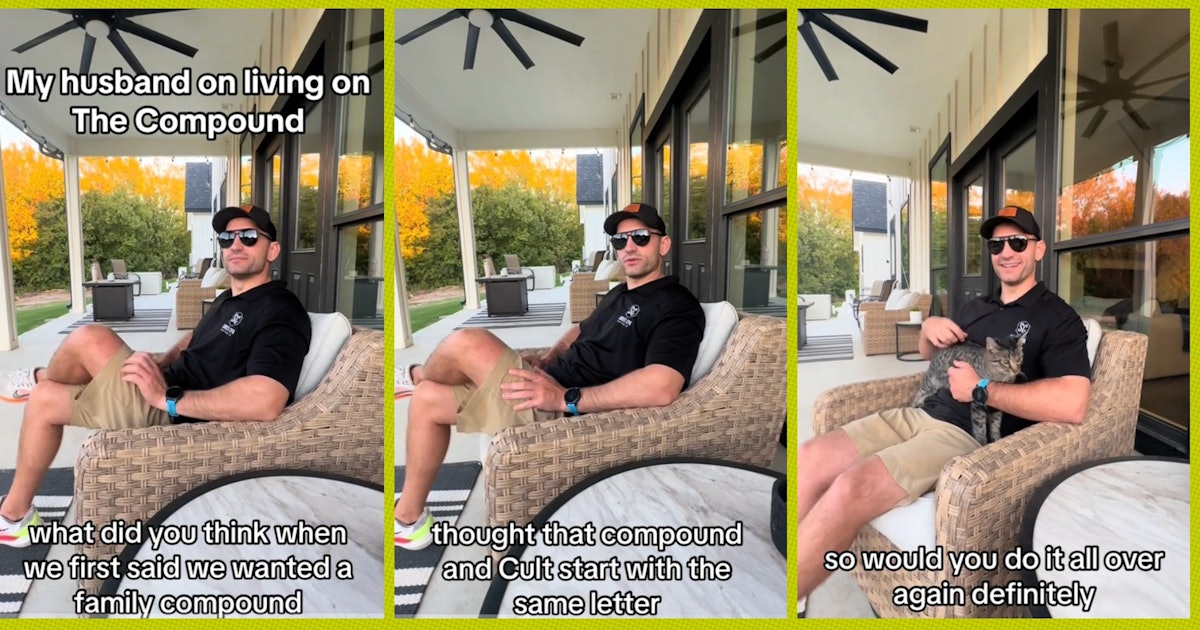
[ad_1]
The pandemic made people do a lot of “unconventional” things in the name of space, safety, and comfort. People in the city moved to the ‘burbs, and many people in the ‘burbs bought land to live in more rural areas. Interestingly, the latter camp includes a rapidly increasing subsect: people who’ve built family compounds. In fact, according to Google, search interest in “family compound” has reached a 10-year high in the United States. But what exactly is it? And why are so many people on social media suddenly obsessed with the idea?
While multigenerational households have almost always existed, there’s a resurgence in the desire and undertaking of compounds. As more people dive into compound life and decide to document their lives on Instagram and TikTok, more interest builds in this alternative arrangement.
But is it feasible for your family? What about you and your friends? After all, for some people, the idea of living next door to their mother-in-law sounds like fresh hell — while the concept of a block full of your besties and their kids sounds like a utopian dream. Either way, there’s room for both versions in the compound (or mompound) life.
What is a family compound?
The Woodhouse Timber Framing Company described compounds as multiple homes on the same property. This might look like a farmer who owns hundreds of acres and builds houses for each of his kids on that acreage. Modern compounds might also look like several friends or family members all buying homes on adjoining lots.
The idea is simple: Keep your loved ones nearby so you can help each other out and benefit from each individual’s skills or assets.
One of the many compound-living TikTokers recently took to social media to share their husband’s initial reaction to starting a compound.
“I thought that compound and cult started with the same letter,” admitted Teran Sands’ husband. But when asked if he liked living on the family compound and would do it again, he quickly answered: “I do. Definitely.”
Do you have to own a ton of land to have a compound?
While many compounds are founded on family land that takes up acres and acres of space, that’s not the only way to go. You’ve no doubt read about “mommunes” or “mompounds,” where single or divorced moms have found better parenting success living with or near their mom friends so they can all help each other out with chores and childcare. You may even daydream about a similar scenario when you have a bad day with your unhelpful partner.
Similarly, a compound can be as simple as buying the house next door to your parents, best friend, or sister and tearing down the fence that separates your property. This allows your kids to easily move between homes while keeping the rest of the fencing in place, ensuring they’re safe on both properties. Such an arrangement might not be the traditional definition of a compound, but it works in modern society.
Why have a compound?
During the pandemic, compounds (both physical and theoretical) became a way for families to “stay together” but still isolate themselves from the outside world. A cursory scroll of compound dwellers on social media suggests the motivation is often the same: Life is hard. The world is scary. Knowing you have help or comfort in your backyard or next door can go a long way toward your happiness and survival.
But, again, compounds have existed across many cultures for many generations. In many cultures today, grandparents live under the same roof as their kids and grandchildren. According to the United Nations, intergenerational living situations can lead to benefits like increased infant feeding, better physical and cognitive development, and better social skills. Not to mention, it’s well-documented that grandparents who live with family are less likely to develop dementia or for the onset to slow significantly.
You can’t discuss the advantages of a family compound without including the financial aspect, either. If a group starts a family compound by pooling resources to buy a large plot of land in a desirable and safe area, everyone benefits from securing property they may not have been able to afford on their own. It also means families can pitch in resources to address concerns about the property.
Living with others simply tends to make life a little easier, too. Everyone can play to their strengths, often resulting in more efficiency and time for self-care.
How do you have a “successful” or “healthy” compound?
TikToker Kari Rogerson, who lives on a 20-acre family compound with her and her husband’s parents, swears the key to keeping a compound healthy and functional is to start by setting clear rules.
This goes beyond just saying, “Grandpa is in charge of spraying for bugs, and Dad is in charge of mowing.” The rules cover everything that might come up in life and death. The Rogerson family compound rules are:
- Everyone needs life insurance.
- A written agreement is in place in case anyone wants to leave.
- Everyone communicates often/truthfully.
- Everyone has their defined (and agreed upon) roles and responsibilities.
- Boundaries are set and abided by.
- Regular family meetings are a requirement.
- You must be flexible in your thinking, and compromise when needed.
- Majority rules when a compromise can’t be made.
- They have an attorney familiar with compounds.
- Everyone participates in long-term legal and financial planning.
- All bills are split equally between each nuclear family.
So, having a family compound that isn’t a total sh*tshow means setting boundaries and applying those to everything: relationships, child-rearing, work (especially if anyone is home), sickness, etc.
Is a compound right for you?
No one can answer that but you and your family. However, compounds or co-living seem to be healthy, financially sound options as long as all parties are on the same page, open, and honest.
[ad_2]